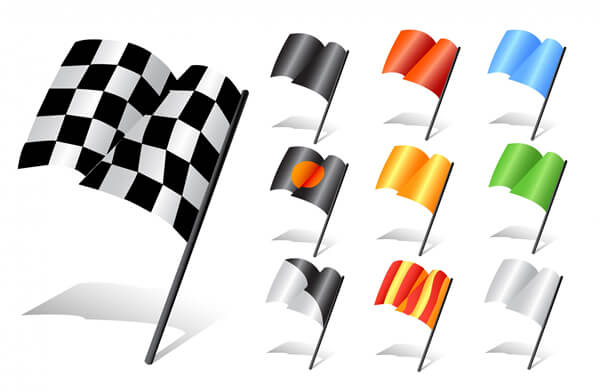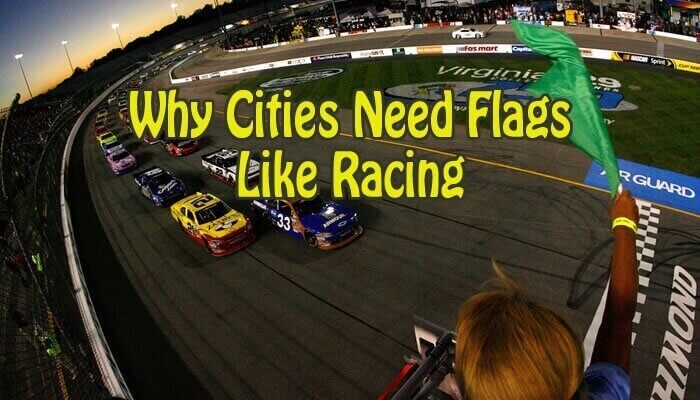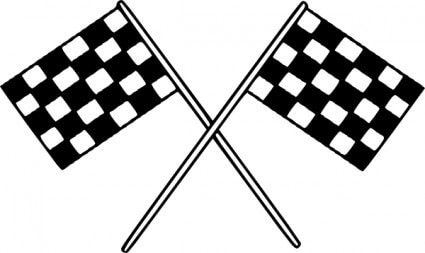Important Note:the use of flags is meant to incorporate the visual symbols developed by hundreds of years of racing. It does not mean physical flags. Its implementation would be fully electronic, consisting of everything from projected flags on surfaces, roadways, and vehicles, to mobile units that could be used in any vehicle. These units would display the “flags,” provide auditory notifications, and help connect the network.
City Life
This post was inspired by a friend’s experience of seeing a car hit an ambulance on New York City’s FDR crawl-way, which resulted in hours of delays. Having lived in NYC and the NYC area for years, it made me wonder why safety isn’t better in such a bustling metropolis. Then I realized, if cities worked like racetracks they would be far safer!
The racing flag system is designed to communicate with drivers.
An Electronic and visual evolution will only multiple its fundamental value and usefulness.
Why the system racetracks’ use is unique, and how flags work:
Rule #1 – All traffic goes the same direction.
On racetracks, oncoming traffic only happens when a car spins and is headed towards you. While it’s true cities have many two-way streets, most traffic arteries have barriers down the middle segregating directions.
Rule #2 – Racing uses flags
All road racing, i.e. Formula 1, MotoGP, NASCAR, World Challenge, IMSA, etc., utilize similar ideas of safety with flags playing the critical role of communication between safety personnel and racers.
Flags are necessary for racing to operate.
Our cities rely on outdated and primarily static traffic signs and lights, compared to the quick and dynamic nature of flags.
We deserve better for our city streets and roadways.
Road racing developed a flag system out of necessity. As safety is paramount, an effective and fast-working system was needed.
A similar, fast-working and highly visual, and interactive system and network takes the concept to new level of efficaciousness.
Six Flags
Using six common racing flags, I will show you how this idea can change safety in every city in the world via an Electronic and visual evolution of this highly-successful idea.

You can pass it, but exercise caution and don’t do anything stupid.
Red Flags indicate something bad has happened, and all racers should check their mirrors and come to a calm, controlled, stop by the closest Flag Station.
It does not mean slam on the brakes without looking behind you!
Yellow Flags indicate something has gone wrong LOCALLY no passing is allowed and you must exercise caution – similar to a Yellow Light.
Yellow Flags can be singular, continue to several stations, or become a full course caution. Regardless, they indicate you need to pay attention because something is amiss.
Debris Flags are red and yellow and indicate debris is on the track surface that may affect your vehicle. It does not indicate what kind of debris, liquid versus solid, but it alerts you to pay attention.
The Meatball Flag is black with an orange “meatball” in the center. This indicates to the vehicle’s driver, and others, that something is mechanically wrong with the vehicle – smoke, liquids, objects separating from the vehicle, etc. You need to get OFF the track and fix it.
I would love to use this flag on the street! The things you see are insane.
Black Flags pointed at you, indicate you did something wrong and need to get off the track. If a Black Flag is at all stations, EVERYONE needs to get off the track.

Fascinating, but how does this help civil driving safety?
I’m glad you asked! Imagine if the same flagging system was used on city roadways to communicate with drivers. Today, implementing a standardized safety broadcast and display near the road surface, within cars, and ON the car’s surface is not only possible, but it can pay for itself.
Combined with mobile devices that can be used in any vehicle which can project and show “flags” and provide audio signals, the level of safety could be exponentially improved.
Would it take time for people to adjust? Of course, which is why you roll out the technology in stages. Every stage would be a vast improvement of what we have now. Start a rollout with projected “flags.” Then add the mobile device, and eventually display “flags” on vehicles.
Imagine if streets themselves and other vehicles indicated traffic and safety information.
Every time an accident occurs in the city, effects of congestion are magnified.
How much money does it cost to pay the fire department, police, ambulances, and numerous other responders that are involved?
How much productivity is taken from everyone involved?
Accidents cost a fortune and make less money available to the city for useful things. Time and productivity lost from work for all parties involved.
Add for damages to public and private property, court cases and personnel, healthcare bills, insurance payments, etc., and costs swell.
Savings from having fewer accidents, which also affect a smaller area and less people, by increased communication, I believe, will pay for the cost of implementation many times over.
Safety Dance
We already have the flagging standards for driver communication from racing that can be adapted to city safety. Any system alerting drivers by flags would be immensely safer than what we have now.
This system could operate on existing traffic bands, or AM / FM, UHF, etc. plus WiFi. Car-to-car broadcasting technology has been expected to be available by the 2020 model year.
Logically, the system would need to be continuously updated. Radio and WiFi can be combined with vehicle-to-vehicle transmission to learn events as they happen, and push the information to other cars and network.
88 MPH
Our vehicles will shortly pass through a line of before and after vehicle connectivity. The more the vehicles speak to each other, the safer things will be, especially in crowded cities. With the power of technology available, we deserve far better traffic safety in every city.
The effective racing flag system can be projected on surfaces or shown in and on vehicles.
I believe the Racing Flag system combined with traffic lights and street signs would vastly increase safety and lower accidents and associated costs, save lives, provide far more information to drivers, and could also lay the foundation for self-driving vehicles in crowded cities.
Real-time delivery of traffic information, which is critical to the system I’m suggesting, offers the best way to make cities safer.






